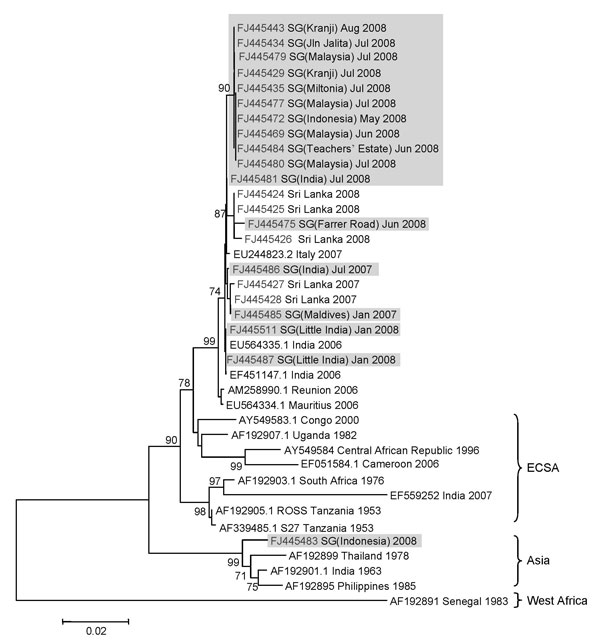Entomologic and Virologic Investigation of Chikungunya, Singapore
Lee-Ching Ng

, Li-Kiang Tan, Cheong-Huat Tan, Sharon S.Y. Tan, Hapuarachchige C. Hapuarachchi, Kwoon-Yong Pok, Yee-Ling Lai, Sai-Gek Lam-Phua, Göran Bucht, Raymond T.P. Lin, Yee-Sin Leo, Boon-Hian Tan, Hwi-Kwang Han, Peng-Lim S Ooi, Lyn James, and Seow-Poh Khoo
Author affiliations: National Environment Agency, Singapore (L.-C. Ng, L.-K. Tan, C.-H. Tan, S.S.Y. Tan, H.C. Hapuarachchi, K.-Y. Pok, Y.-L. Lai, S.-G. Lam-Phua, G. Bucht, S.-P. Khoo); Tan Tock Seng Hospital, Singapore (R.T.P. Lin, Y.-S. Leo); Ministry of Health, Singapore (B.-H. Tan, H.-K. Han, P.-L. S. Ooi, L. James)
Main Article
Figure 2

Figure 2. Phylogenetic analysis of the chikungunya virus (CHIKV) envelope 1 (E1) gene. The maximum-likelihood method was used to construct the phylogenetic tree by using 1,002 nucleotides of the sequence of the E1 gene from codons 91 to 424. The tree included 17 isolates detected in Singapore (shaded), 5 Sri Lankan isolates sequenced at the Environmental Health Institute, and 17 global sequences selected to represent all known phylogenetic lineages. In the tree, all sequences are labeled with GenBank accession numbers and country of origin, and are isolated by year/month. In addition, all locally acquired and imported Singapore isolates are labeled with the reported area and country of origin, respectively, within parentheses. Only the bootstrap values >70 are shown on branches. Scale bar indicates nucleotide substitutions per site. ECSA, East, Central and South African genotype; SG, Singapore.
Main Article
Page created: October 04, 2010
Page updated: October 04, 2010
Page reviewed: October 04, 2010
The conclusions, findings, and opinions expressed by authors contributing to this journal do not necessarily reflect the official position of the U.S. Department of Health and Human Services, the Public Health Service, the Centers for Disease Control and Prevention, or the authors' affiliated institutions. Use of trade names is for identification only and does not imply endorsement by any of the groups named above.
